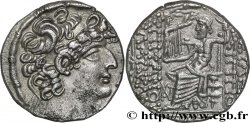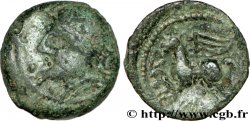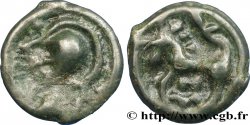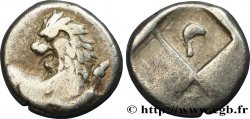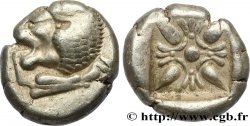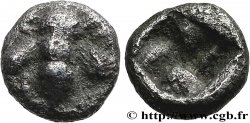v26_0163 - SYRIA - RÖMISCHE PROVINCIA - QUINTUS CAECILIUS Tétradrachme syro-phénicien
MONNAIES 26 (2006)
Startpreis : 350.00 €
Schätzung : 550.00 €
unverkauftes Los
Startpreis : 350.00 €
Schätzung : 550.00 €
unverkauftes Los
Type : Tétradrachme syro-phénicien
Datum: an 4
Name der Münzstätte / Stadt : Antioche, Syrie, Séleucie et Piérie
Metall : Silber
Durchmesser : 26,5 mm
Stempelstellung : 12 h.
Gewicht : 15,03 g.
Kommentare zum Erhaltungszustand:
Très beau portrait avec une jolie patine de médaillier. Frappé sur un flan un peu court pour le revers. Flan légèrement taché sur l’arrière du trône au revers
N° im Nachschlagewerk :
Prieur 5 - RPC.4128
Vorderseite
Titulatur der Vorderseite ANÉPIGRAPHE.
Beschreibung Vorderseite Tête diadémée de Philippe Philadelphe à droite, entouré de la stemma.
Rückseite
Beschreibung Rückseite Zeus nicéphore assis à gauche sur un trône avec dossier, tenant une Niké de la main droite et un sceptre long de la main gauche ; monogramme dans le champ à gauche ; date à l’exergue.
Legende des Reverses : BASILEWS/ FILIPPOU/ EPIFANOUS/ FILADELFOU, (Basilews Filippou Epifanous Filadelfou)
Übersetzung der Rückseite (Roi Philippe Epiphane Philadelphe/ monogramme d’Antioche).
Kommentare
Semble de même coin de droit que l’exemplaire reproduit dans l’ouvrage de K. et M. Prieur (p. 4 n° 5). Dans la base TSP, Michel Prieur a répertorié 40 tétradrachmes. Cet exemplaire est référencé sous le numéro (TSP. 0005_037). Sur dix exemplaires recensés par les auteurs du Roman Provincial Coinage, six au moins se trouvent dans des musées : Paris, Londres, New York, Munich (2 ex.). Deux exemplaires proviennent de trésors ou de fouilles : Sarnakounk (IGCH 1746) découvert en 1945 qui contenait 373 pièces d’argent dont 210 deniers et 58 tétradrachmes dont un exemplaire de l’an 4 ; le second tétradrachme, des fouilles de Dura V (E. T Newell, NNM 58, 1933) avec vingt tétradrachmes dont quinze posthumes et un de l’an 4.
Seems to have the same obverse die as the example reproduced in the work by K. and M. Prieur (p. 4 no. 5). In the TSP database, Michel Prieur listed 40 tetradrachms. This example is referenced under the number (TSP. 0005_037). Of the ten examples listed by the authors of the Roman Provincial Coinage, at least six are in museums: Paris, London, New York, Munich (2 examples). Two examples come from hoards or excavations: Sarnakounk (IGCH 1746) discovered in 1945 which contained 373 silver coins including 210 denarii and 58 tetradrachms including one example from the year 4; the second tetradrachm, from the excavations of Dura V (E. T Newell, NNM 58, 1933) with twenty tetradrachms including fifteen posthumous and one from the year 4
Seems to have the same obverse die as the example reproduced in the work by K. and M. Prieur (p. 4 no. 5). In the TSP database, Michel Prieur listed 40 tetradrachms. This example is referenced under the number (TSP. 0005_037). Of the ten examples listed by the authors of the Roman Provincial Coinage, at least six are in museums: Paris, London, New York, Munich (2 examples). Two examples come from hoards or excavations: Sarnakounk (IGCH 1746) discovered in 1945 which contained 373 silver coins including 210 denarii and 58 tetradrachms including one example from the year 4; the second tetradrachm, from the excavations of Dura V (E. T Newell, NNM 58, 1933) with twenty tetradrachms including fifteen posthumous and one from the year 4








 Berichten über einen Fehler
Berichten über einen Fehler Die Seite drucken
Die Seite drucken Teilen meiner Auswahl
Teilen meiner Auswahl Stellen Sie eine Frage
Stellen Sie eine Frage Einlieferung/Verkauf
Einlieferung/Verkauf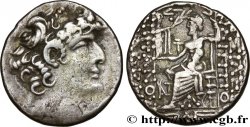
 Details
Details

